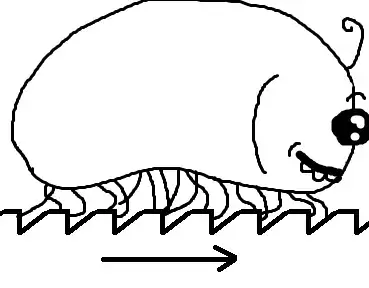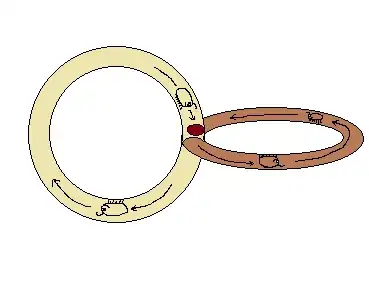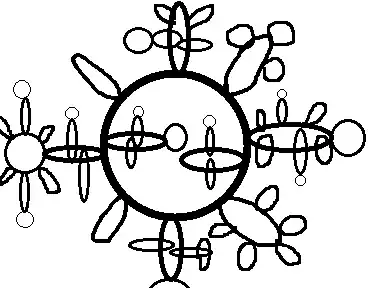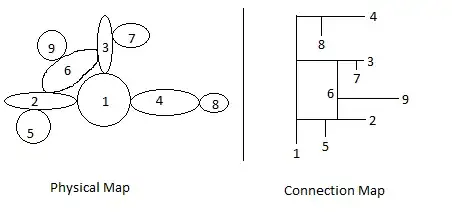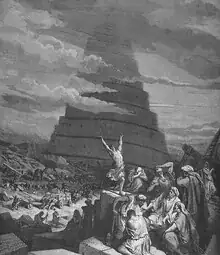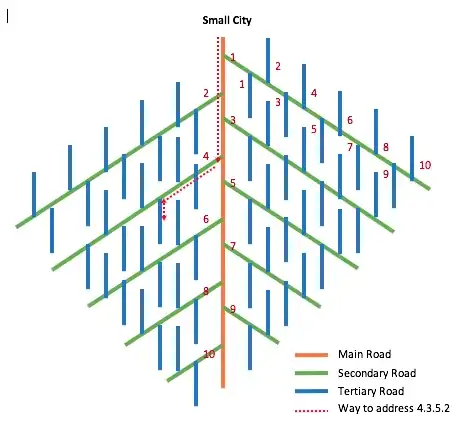Every answer I see here violate, in some manner, the question being asked. Fran is stated as not being able to tell East from West as well as Left from Right. That is, if Fran is pointed East she is unable to distinguish this from being pointed West (other than what is directly in front or behind, due to some concept of "vision").
Ergo I think I know what Fran is.
She is a being that has precisely two light-sensing patches on her: one fore, one aft.
These vision patches are not capable of distinguishing objects. They're closer to being a laser range finder. She can tell the color, distance, and material of an object in front of her and behind her. But she cannot distinguish anything else. A red dixie cup would be indistinguishable from any other piece of red plastic.
Furthermore these two vision patches cannot move independently. They are inextricably linked in a form of hard structural rigidity with both each other and her locomotive system. Additionally her locomotive system has no concept of "no, turn the other way." Turning is turning. There is no, "I see it, I see it, I see it, now I don't, go back" order that she can give to her locomotive system in order to reverse direction.
Which means....she can only turn in one direction. So not only can she not tell which direction she's rotating in she has no control over it in order to turn around. She only has three commands as it were for movement: forward, backward, and turn. 1
At this point I've decided that there's no way this species would survive to sentience. Even a snail can tell that nope, that way is bad, turn the other way.
Fran would have to be completely cylindrical (symmetrical around the up-down axis, the other two are irrelevant), for if she were not, she would get stuck up against a rock or a tree, unable to turn away from it, and then starve to death (or get eaten, or...) and rapidly go extinct.
I have no idea what a city built by her people would even look like. Simple things like hinges would boggle their minds, because hinges would have to bend in a non-uniform way. We also have to do away with gears because those rotate non-uniformly when meshing with each other. At this point you have to basically discount every possible piece of technology above the stone age.
Fran does not live in a city. She's a barely cognizant animal living on a vast rolling plane of grass with no carnivorous animals (or her species reproduces too quickly for it to matter). She's basically blind, deaf, can't move quickly (or at all), and almost certainly either an herbivore or a composter (i.e. feeds off rotting organic matter).2
1 Even this violates the uniformity of movement: turning while moving forward and turning while moving backwards are not mirrors of each other. That is, if an object moves forward 1 unit and rotates local-left 1 unit and repeats this pattern, it will move in a counter-clockwise circle. If it moves backwards 1 unit and rotates left 1 unit, it will move in a counter-clockwise circle. This is important because it does not retrace the path, ergo moving forward and turning and moving backward and turning get you to different places and imply a directionality difference of left and right!
There are only two ways to fix this:
- make Fran unable to distinguish an object in front of her from one behind at which point all logic and reason have been defenestrated out of the building.
- make Fran unable to rotate while moving, which seems like a very poor survival strategy
Lets assume #2.
2 Dear god, she's a pre-Uplift Traeki.
Update 5-29-17
As some folks have expressed derision over whether or not mirrored vision is able to sense direction, I built a quick application to test that theory. The compiled executable is not very stable, but if you wish to try it out for yourself, you can find it here (Windows executable, you assume the risks of running arbitrary internet code yourself).
- Controls are randomized, but the keybinds for movement and look rotate are bound to WASD/IJKL in pairs (that is, W and S always perform inverse operations).
- The initial boot will be in Vision Mode 0, which is as I have described above (only distinct along the vertical axis). If you can figure out what any of the keys do in this mode, good job. If not, then point proven: it is impossible to distinguish left from right in this mode.
- Press Q to change modes. Vision Mode 1 is mirrored and Vision Mode 2 is human standard. Controls are shuffled each time the vision mode switches.
- I recommend running in 640x480 as the mirrored effect has to pipe data off the GPU back to the CPU, compute, then return it (i.e. slow as all hell). This is also why the application crashes frequently.
- I would have compiled to WebGL if it hadn't hung during the compile process (Unity bug?).
In mirror vision you can navigate although identifying which direction is objectively left may not be possible, but it can be distinguished from objective right and a creature with this sort of vision would have no trouble tracking down a lemonade stand.
You can watch me navigate the simple maze in this video and aside from some orientation and forgetfulness over which key I need to press next (i.e. moving backwards instead of forwards), you can easily identify when I turn the wrong way briefly before correcting to turn the correct way. There are a few places were I made a decision based on knowing the actual layout of the maze (not having to investigate dead ends) but I think that it is sufficient proof that navigation under this mode of vision is possible and that leftness and rightness can be understood as distinct, even if not readily identifiable (that is, if the world were flipped left to right and the controls were flipped left to right, I would be unable to tell).
That is, given this perfectly centered view, it is impossible to tell if the branch path is to the left or to the right. But by rotating to one side or the other you can see that in one case the branch is farther away from center and in the other, it's closer. And closer to center is "forward" and if that's the direction you want to go, then having it be forward is desirable, ergo the two rotations are distinct and can be labeled as such.
On the other hand this is just meaningless and contains no directional information at all (standard view of the same scene at the same point in space and time).
